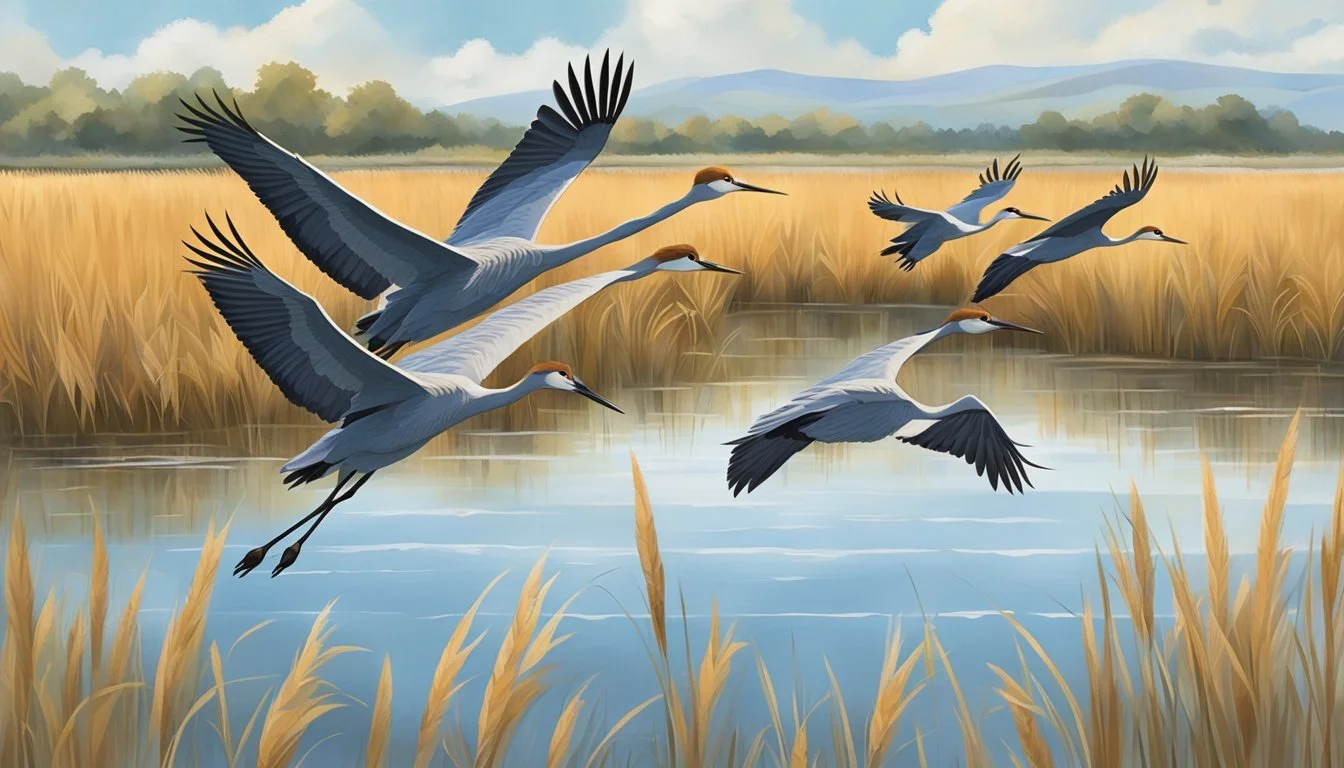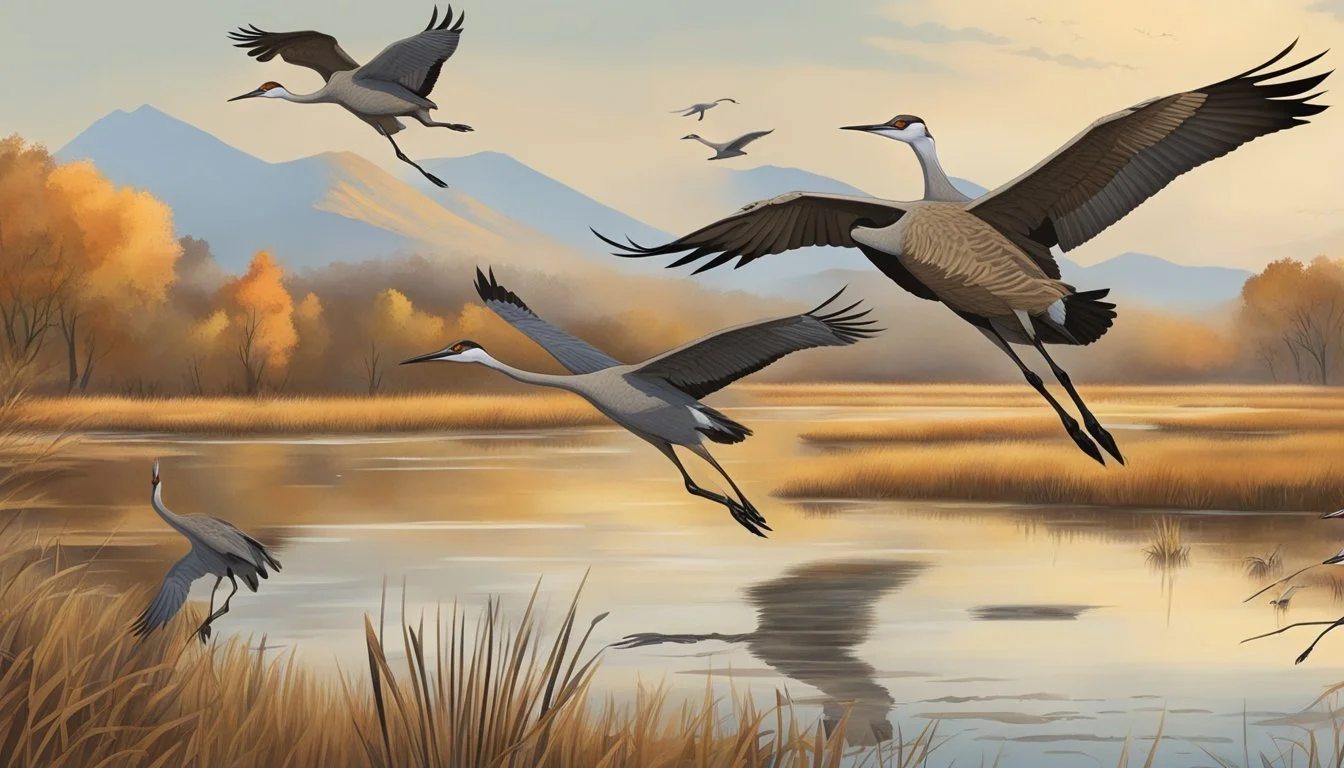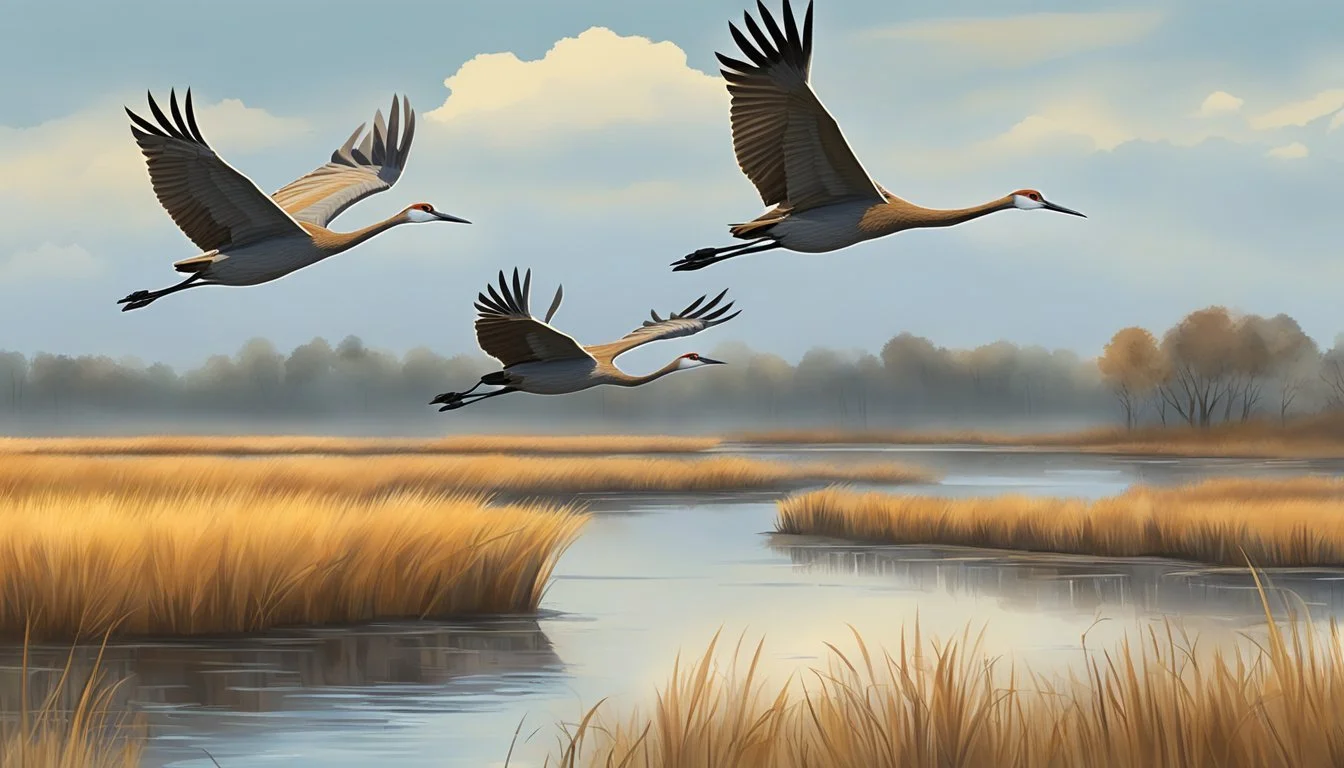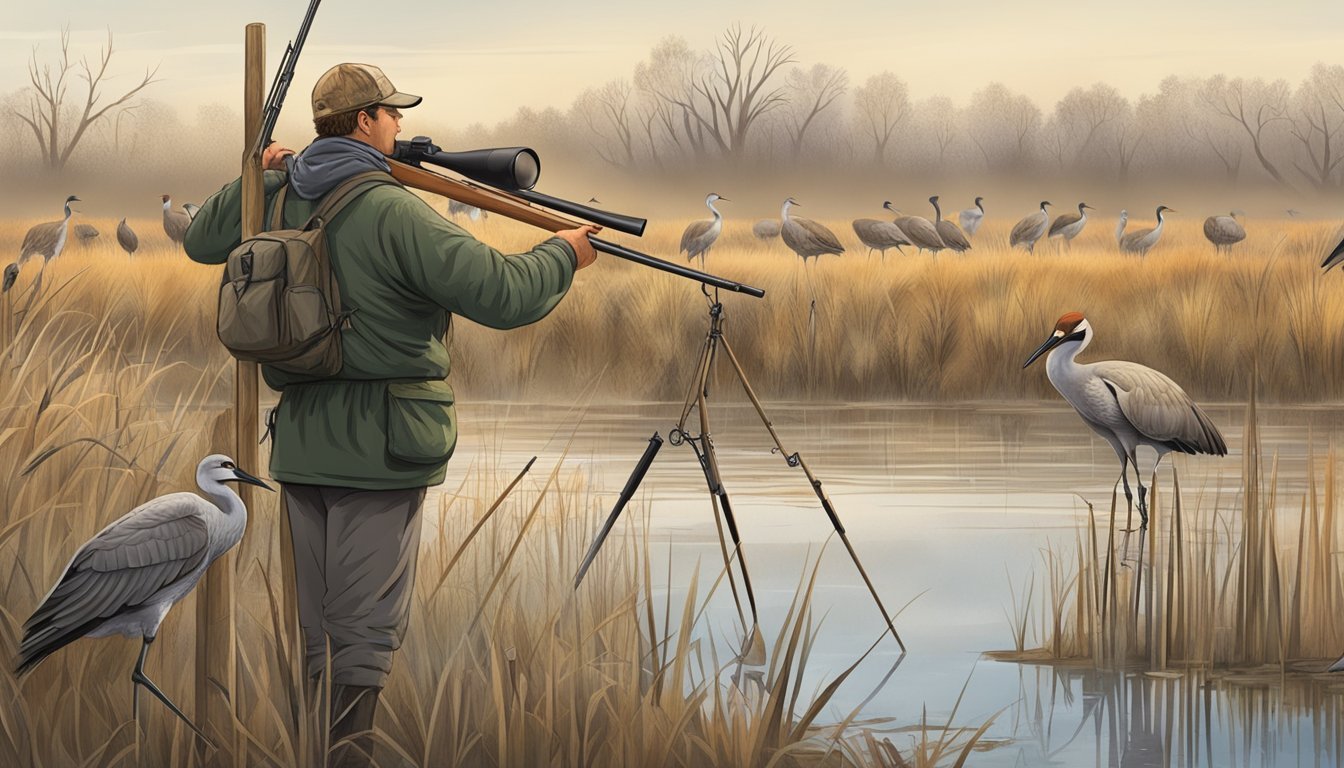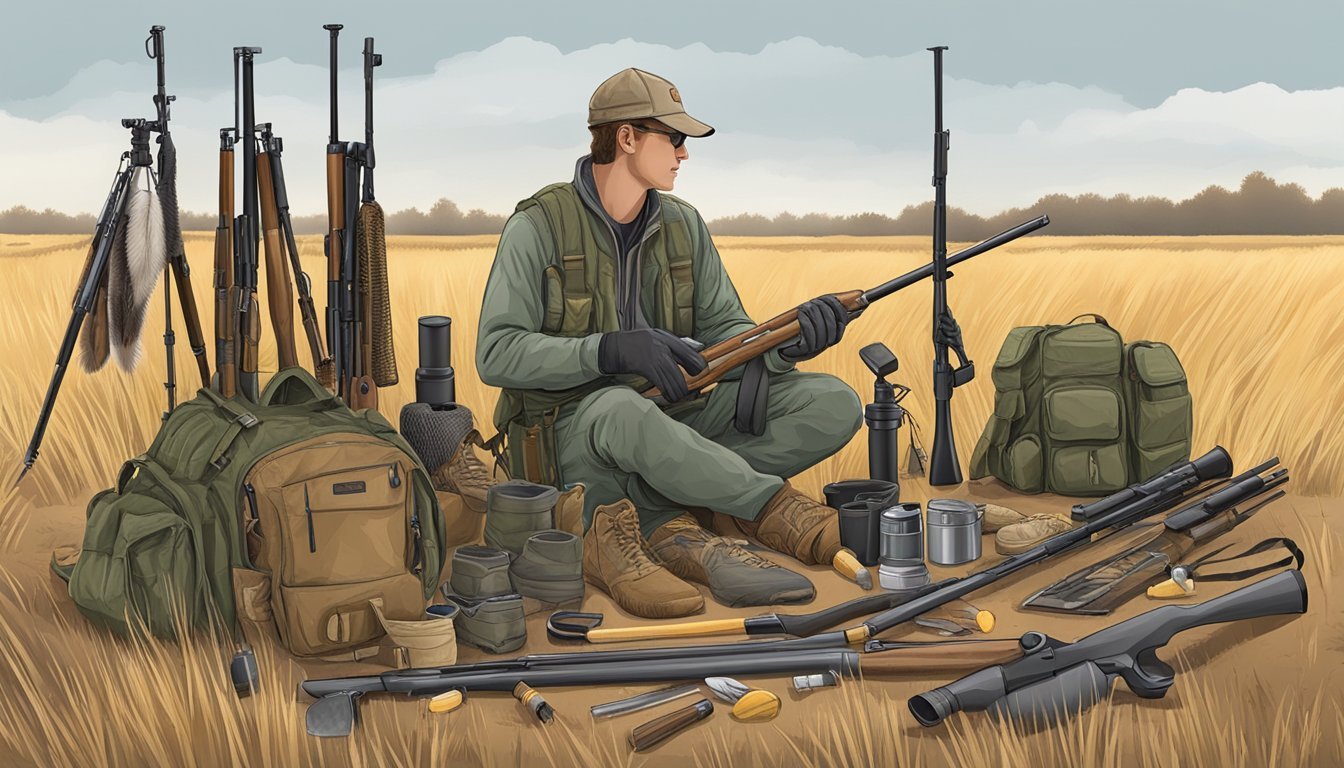Sandhill Crane Hunting Seasons
Regulations and Timelines Across States
This Article is Part of Our Guide on Hunting Seasons for Over 70 Common Game Species
Sandhill crane hunting has become an increasingly popular activity among hunters, appreciated not only for the challenge it presents but also for the culinary rewards it offers. Often referred to as "The Rib Eye of the Sky," sandhill cranes are pursued for their rich and savory meat. Six subspecies of sandhill cranes are recognized in North America, with three of these established as non-migratory, remaining in one region throughout the year. This bird's growing popularity as a game species has prompted a number of states across the U.S. to establish designated hunting seasons.
Regulation of sandhill crane hunting is meticulous, with specific seasons set by each state to ensure sustainable management of the crane populations. For instance, in Texas, the hunting seasons are outlined across three different zones: Zone A, B, and C with specified time frames, such as October 28, 2023, to January 28, 2024, for Zone A and B, and December 16, 2023, to January 21, 2024, for Zone C. These regulations are carefully designed to align with the cranes' migratory patterns, ensuring that hunters have opportunities while also promoting the conservation of the species.
In areas like Tennessee, sandhill cranes are not only hunted but also celebrated, as they winter in significant numbers and become a spectacle for both birdwatchers and hunters alike. Locations such as the Hiwassee Wildlife Refuge see thousands of sandhill cranes, making them an iconic part of the local wildlife and an important consideration for regional conservation efforts. The balance between hunting traditions and ecological management is a critical component of the overarching wildlife conservation strategy that allows for continued enjoyment and respect for the sandhill crane species.
Conservation and Population
The conservation and management of Sandhill Cranes in North America are crucial due to their varying population statuses and the presence of different subspecies, each with its own set of conservation needs.
Species and Subspecies
The Sandhill Crane, Grus canadensis, is a bird species native to North America with several notable subspecies. These include the Lesser Sandhill Crane, the Greater Sandhill Crane, and the Canadian Sandhill Crane, among others. Each subspecies inhabits different regions and exhibits varying migratory patterns.
North American Population Overview
Sandhill Cranes are widespread across North America, with populations ranging from the Eastern Population (EP) to the Mid-Continent Population (MCP). The EP, which has been discussed in the context of management plans since the 1980s, has experienced issues related to its increasing numbers. Meanwhile, the MCP historically faced a ban on hunting which lasted from 1918 to 1960, with controlled hunting seasons resuming thereafter.
Eastern Population (EP): Increasing population.
Mid-Continent Population (MCP): Once had a hunting ban; now with regulated hunting seasons.
Migration Patterns
Sandhill Cranes exhibit complex migratory behavior, with some populations making long journeys across various flyways. The EP migrates through the Atlantic and Mississippi Flyways, while the MCP travels annually along routes that include states such as Colorado, Kansas, and Texas, among others.
Migratory: Travel across flyways including Atlantic, Mississippi, and Central.
Non-Migratory: Some populations do not migrate and are resident year-round.
The sustainability of Sandhill Crane populations is supported by ongoing conservation efforts, with a focus on understanding and managing their migratory patterns and maintaining ecological balance across regions.
Legal Framework
The legal framework governing sandhill crane hunting is structured by a combination of federal and state regulations and requires appropriate permits and adherence to ethical hunting practices to ensure the species' conservation and the safety of other non-targeted birds.
Federal and State Regulations
Sandhill crane hunting is regulated at both the federal and state level to ensure sustainable harvests and protection of migratory bird populations. The U.S. Fish and Wildlife Service oversees the federal regulations under the Migratory Bird Treaty Act, which dictates the hunting seasons, bag limits, and areas where hunting is permitted. Each state may further tailor these regulations to address local conservation needs and hunter opportunity.
For instance, in Texas, the Texas Parks & Wildlife Department sets specific hunting seasons for sandhill cranes within different zones:
Zone A: Oct. 28, 2023 – Jan. 28, 2024
Zone B: Nov. 24, 2023 – Jan. 28, 2024
Zone C: Dec. 16, 2023 – Jan. 21, 2024
These dates reflect the state's adaptation within the federal guidelines.
Permits and Licenses
Hunters pursuing sandhill cranes must obtain the appropriate state hunting license along with a migratory game bird endorsement to participate in the season. In Texas, this requirement takes the form of the Texas Migratory Game Bird Stamp Endorsement. Additionally, a federal sandhill crane hunting permit, known as the Federal Sandhill Crane Hunting Permit, is often required to harvest these birds legally. The process of obtaining these permits ensures that hunters are recognized and accountable for following the migratory game bird regulations.
Hunting Ethical Considerations
Ethical considerations in crane hunting involve the proper identification of the target species to avoid the accidental shooting of non-targeted and protected species like the whooping crane. Hunters are expected to maintain a level of conduct that supports conservation efforts and respects the legal and ethical boundaries set by regulatory bodies. Hunting education often covers the importance of these ethical practices, aiming to promote a responsible hunting community.
Seasonal Information
The Sandhill Crane hunting season is a period eagerly anticipated by hunters, with specific dates varying by state, reflecting the migratory patterns of the birds. These hunting seasons are influenced by both state regulations and ecological factors to ensure sustainability.
Typical Hunting Seasons by State
Texas:
Zone A: October 28, 2023 - January 28, 2024
Zone B: November 24, 2023 - January 28, 2024
Zone C: December 16, 2023 - January 21, 2024
Kentucky: Established a hunting season in 2011. Tennessee: Followed suit, commencing its Sandhill Crane hunting season in 2013.
Other states known for Sandhill Crane hunting include New Mexico, Montana, Oklahoma, Kansas, Minnesota, North Dakota, and South Dakota. These states typically schedule their hunting seasons in the fall, ranging from as early as September to as late as January.
Migration Considerations and Season Timing
The timing of Sandhill Crane hunting seasons takes into account the birds' migratory patterns along various flyways. States align their season dates to ensure hunting occurs during periods when the birds are present in the region. For example, the Central Flyway hosts states like Texas, where hunters target Sandhill Cranes during their winter migration.
Northern States and Canada: Hunting seasons may begin in fall, as Sandhill Cranes migrate south from their breeding grounds in Canadian provinces and northern states like Alaska.
Southern States: Seasons often extend into January, when the migration concludes and Sandhill Cranes settle in warmer climes for the winter.
Regulating agencies in each state or province carefully consider these migration timelines to set appropriate hunting seasons that avoid endangering the birds during critical breeding or rearing times.
Hunting Practices and Techniques
Sandhill crane hunting requires skillful use of decoys and calls, paired with strategic approaches to maximize the harvest. Successful hunters often employ a blend of these tools and tactics to effectively mimic the environment and behaviors of these waterfowl.
Decoys and Calls
Hunters utilize decoys to create a convincing scene that sandhill cranes will approach. A mix of decoy types can be effective, with full-body decoys being a popular choice. The utilitarian placement is as important as the decoy variety, often in a spread that mimics feeding or resting cranes. For calls, hunters should employ recordings or manually blown calls that replicate the unique rolling bugle of sandhill cranes. Meticulous attention to the subtleties of these sounds can greatly enhance the lure.
Decoy Setup Example:
6 full-body decoys
4 feeder decoys
2 sentinel decoys
Calls:
Electronic recordings
Manual crane calls
Successful Strategies
Hunters need to understand the behavioral patterns of sandhill cranes for a fruitful hunt. They often feed in leftover agricultural fields where they can be hunted using blinds and effective concealment techniques. Hunters should match their techniques to the cranes' environment, using nontoxic shot due to regulations. It's also crucial to recognize that sandhill cranes are wary birds, demanding patience and precise shot timing for a successful harvest.
Key Strategies:
Concealment in natural or constructed blinds
Patience and observation to determine prime shooting time
Ethical hunting practices complying with local limits and regulations
Shooting Tips:
Use of nontoxic shot
Understanding of crane flight patterns
Effective range estimation
Each of these practices and techniques greatly enhances the hunter's capacity to ethically and effectively pursue sandhill cranes during the designated hunting seasons.
Bag Limits and Records
In managing Sandhill crane populations, specific regulations dictate both daily and seasonal harvest limits, as well as the necessity for accurate record-keeping and reporting by participating hunters.
Daily and Seasonal Harvest
The harvest of Sandhill cranes is highly regulated to ensure the sustainable management of their populations. Daily bag limits are implemented across different zones, with Texas, for example, allowing up to three birds per day in Zones A and B, and two birds per day in Zone C. Possession limits are generally set at three times the daily bag limit. This careful regulation helps maintain a balance between hunters' interests and the conservation efforts for stable crane populations, originating from as far as Siberia.
Texas (Zone A and B): Daily limit of 3, possession limit of 9
Texas (Zone C): Daily limit of 2, possession limit of 6
North Dakota (Unit 1): Daily limit of 3, possession limit of 6
North Dakota (Unit 2): Daily limit of 2
Reporting and Compliance
Hunters must comply with the Harvest Information Program (HIP) registration to track the harvest of migratory birds. Accurate reporting is crucial for wildlife agencies to monitor Sandhill crane hunt activities and adaptively manage crane populations. The HIP assists in the gathering of data to assess the impact of hunting on various migratory birds throughout their ranges, including crane hunting seasons, ensuring that crane population levels remain healthy and viable for future generations.
Equipment and Gear
Hunters gearing up for sandhill crane season need to focus on selecting the right firearms and ammunition for an ethical harvest, and on choosing appropriate clothing and accessories for concealment and comfort in the field.
Firearms and Ammunition
Shotguns: Hunters typically use 12-gauge shotguns for sandhill crane hunting due to their versatility and power. In some situations, a 10-gauge may be chosen for its increased range and payload delivery, which can be advantageous for these large birds.
Ammunition:
Shot Size: Non-toxic shot is mandatory, with sizes ranging from #2 to #BB being most effective.
Knowledge: Hunters must ensure they use high-quality ammunition to maintain efficacy. Shot size smaller than #3 is not recommended.
Clothing and Accessories
Clothing: Apparel should be tailored to the specific environment. Most hunters wear camouflaged clothing to blend in with the natural surroundings.
Accessories:
Identification Test: Hunters are required to pass a sandhill crane identification test, emphasizing the importance of knowledge about the species.
Accessories: To aid in concealment and comfort, hunters often employ blinds and camouflage gear.
This section on equipment and gear provides an overview to prepare hunters for a responsible and successful sandhill crane hunting experience, emphasizing the necessity of suitable firearms, ammunition, clothing, and accessories.
Locations and Access
Successful Sandhill Crane hunting largely depends on understanding the best locations for hunting and obtaining appropriate access to these areas. This section explores prime areas known for Sandhill Crane populations as well as how hunters navigate public and private land permissions.
Prime Crane Hunting Areas
Texas is prominent for its Sandhill Crane hunting, with several zones including Zone A, Zone B, and Zone C, each having specific season dates. Notably, Zone C covers the area south of the Kleberg-Nueces county line up to the Gulf of Mexico, with its own set of regulated dates. Kansas, Oklahoma, and New Mexico offer opportunities as well, featuring habitats frequented by cranes. To the north, Montana, North Dakota, and South Dakota are key states with significant crane populations, bolstered by ample cover in agricultural fields. Minnesota provides a Western Zone with managed hunting seasons, while Kentucky and Tennessee have more recently opened seasons. States like Alaska and Idaho also host hunting seasons, taking advantage of the migratory paths of different Sandhill Crane subspecies.
Public and Private Land Access
Access to hunting grounds in these states varies, with both public and private lands serving as potential hunting sites. Public lands typically require hunters to adhere to specific regulations and possibly secure permits or draw tags through state-run wildlife agencies. For example, in Texas, access to public hunting lands might be regulated by the Texas Parks & Wildlife Department, which provides detailed maps and regulations.
On the other hand, private lands often necessitate permission from landowners. In some states, programs exist to facilitate access to private lands for hunting purposes, but in all cases, respectful coordination with landowners is paramount for access. States like Montana and Kansas have walk-in hunting areas, where private land is made available for public hunting, simplifying access in those areas.
Hunters must always verify the latest hunting regulations and access rights for the specific zones and states they plan to hunt in, as these can change year to year.
Planning Your Hunt
When planning a hunt for Sandhill Cranes, hunters must carefully consider whether to employ the services of a guide or outfitter and give due attention to the trip preparations and expectations.
Choosing a Guide or Outfitter
For many, especially less experienced hunters or those new to Sandhill Crane hunting, opting for a guided hunt is a popular choice. An outfitter typically provides expert guidance on hunting techniques, access to prime hunting locations, and may also assist with the procurement of necessary permits and tags.
Guided Hunt Benefits:
Expertise in bird behavior and habitat
Access to pre-scouted lands
Assistance with legal requirements
Considerations for Nonresidents:
Verify the type of documentation required.
Be aware of any restrictions specific to nonresident hunters.
Hunters should ensure the outfitter is experienced with Sandhill Cranes and can provide all the essential services, including lodging accommodations if needed.
Trip Preparations and Expectations
Thorough preparations are essential for a productive hunting experience.
Requirements and Regulations:
Stay abreast of state-specific hunting regulations.
Obtain the correct tags and understand bag limits.
What to Expect:
Be ready for the physical demands of the hunt.
Acknowledge that success is not guaranteed.
Hunters should prepare for varying weather conditions and ensure they have all appropriate gear. They should also have realistic expectations about the hunt, understanding that patience and persistence are often as important as skill.
By adhering to these considerations, hunters can plan a Sandhill Crane hunt that is both exciting and adherent to regulations, enhancing the overall experience.
Regulation Detail by Region
The regulations for Sandhill Crane hunting vary significantly between regions, with specific season dates and geographic zones to consider. Hunters must adhere to these regulations to maintain compliance and ensure the sustainability of the species.
United States Regulations
In the United States, Sandhill Crane hunting is rigorously regulated with both federal and state-specific rules. The regular hunting season dates are set within distinct zones, ensuring the protection of local populations during critical periods.
Zone A: The season typically runs from October 28, 2023, to January 28, 2024.
Zone B: This zone's season is scheduled from November 24, 2023, to January 28, 2024.
Zone C: Hunting in this zone is restricted to a shorter timeframe, from December 16, 2023, to January 21, 2024.
Hunters should be aware that there are also areas within these zones where hunting might be closed or restricted.
Canadian Regulations
In Canada, provincial regulations govern Sandhill Crane hunting. Saskatchewan and Manitoba, for instance, set their unique season dates which align with migratory patterns, often considering the proximity to bodies of water such as the Gulf of Mexico for migratory species besides cranes, like ducks and coot.
While specific dates and zones may vary by province, hunters are required to follow the local guidelines, which are put in place to sustain healthy populations and respect the natural habitats. The province of Alberta, for example, delineates hunting zones and periods which include:
Northern Alberta: The seasons in these regions can commence as early as September and extend into winter.
Southern Alberta: Hunting may begin later in fall and have distinct closing dates, reflecting the birds' migratory schedules through the region.
For precise season dates and regulations, hunters should consult the latest provincial guidelines before planning their hunt.

